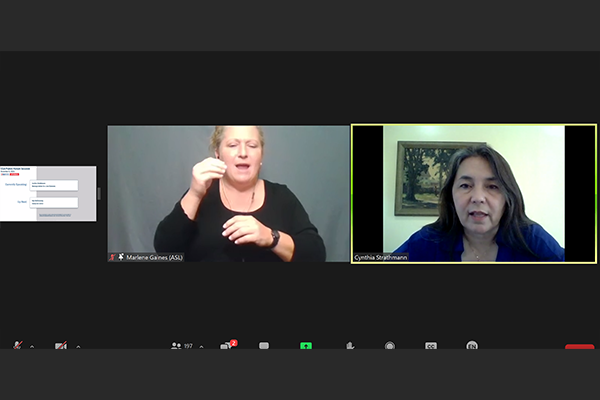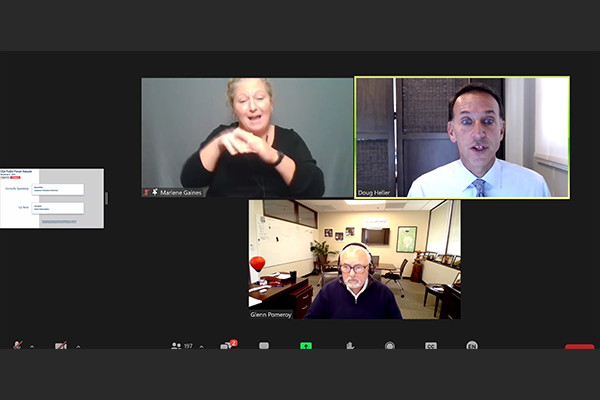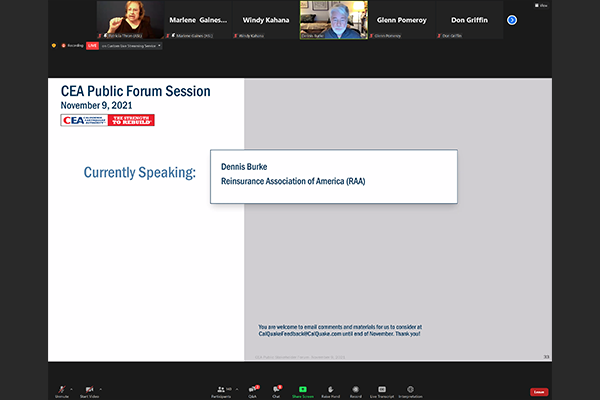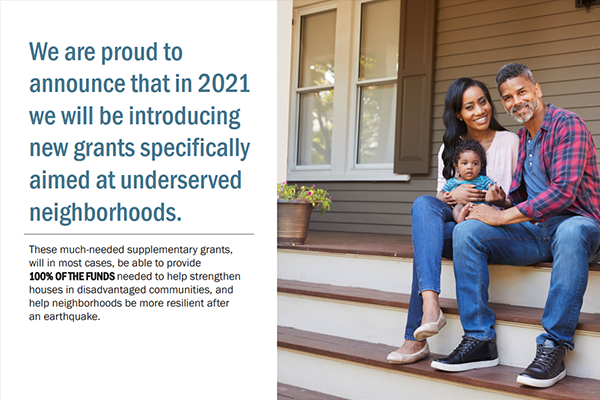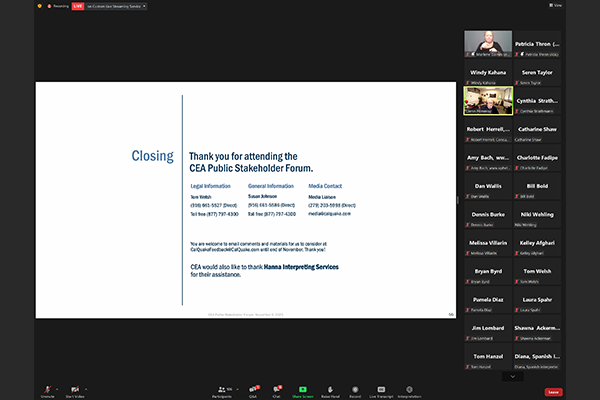CEA was pleased to welcome more than 150 people to its first-ever Public Forum/Listening Session. The online meeting allowed participants to share their thoughts and suggestions as CEA faces a crossroad on how to strike a balance between providing valuable earthquake insurance coverage at a relatively stable rate, while having the financial strength to pay policyholder claims in the wake of a catastrophic event. To allow for broader audience participation, CEA held the Forum via Zoom, with simultaneous Spanish and American Sign Language interpretation. The Forum was broadcast live on social media, also a first for CEA.
Earlier this fall, as an initial effort to avoid the need for significant policyholder rate increases in the coming years, CEA staff communicated to its Governing Board that the organization was contemplating reducing some of the enhanced coverage options it began offering several years ago. However, the board wanted to consider a wider range of options, and hear from a broader group of stakeholders, before deciding on a course of action. So, to create an opportunity for stakeholder engagement, CEA hosted its first Public Forum/Listening Session via Zoom on November 9, 2021.
The participants came from a variety of sectors, including consumer group representatives, industry trade associations, non-CEA earthquake insurance providers, and even CEA policyholders who had recently contacted our Help Desk because they were concerned about rising premiums. Everyone in attendance had the opportunity to voice their opinions.
During the Forum, CEA explained that policyholders’ rates could significantly increase over the next few years due to inflation, home rebuilding costs, as well as increasing reinsurance (insurance for insurance companies) costs, and other factors. “We are looking at some really immediate needs and so we want to be very realistic about what we can accomplish,” said Glenn Pomeroy, CEA CEO.
Participants opined on two main questions:
- What features should a CEA policy include?
- What is the appropriate target for CEA claim-paying capacity?
Those questions sparked a variety of ideas and candid comments. For example, the consumer groups strongly opposed coverage reductions, but were generally in favor of some reduction in the amount of claim-paying capacity CEA maintains. Also, consumer groups generally supported the creation of a state catastrophe fund, backed by taxpayers, to sell reinsurance to the CEA. “Such a fund would eliminate the profit factor that drives up private reinsurance cost,” said Doug Heller of the Consumer Federation of America. “This fund could also sell reinsurance to the private license insurers in California, including those who sell business insurance.”
Industry groups expressed the view that if coverage had to be reduced, lowering the amount of coverage available for personal property is preferable to reducing coverage for additional living expenses. These groups were also receptive to reducing CEA’s claim-paying capacity, but two of the organizations expressed opposition to the creation of a state reinsurance facility. Dennis Burke from Reinsurance Association of America, an industry trade association, said he was concerned about such a suggestion. “People who do not have earthquake insurance will have to pay for their own losses,” Burke said. “Imposing taxes on those individuals to pay for a coverage that they did not have does not seem fair,” he added.
One topic that resonated with most participants was the need for mitigation. By strengthening homes with a seismic retrofit, the potential for severe structural damage decreases, which could translate into a reduction of insurance premiums and reinsurance costs. At the same time, retrofits help more California communities become more resilient and fewer people would likely be displaced after a major earthquake. This is especially important since most Californians live within 30 miles of an active fault.
“Low-income homeowners can’t afford CEA insurance and they are not going to be covered in the event of a major earthquake,” said Cynthia Strathmann from Strategic Action for a Just Economy. “In the event of a huge earthquake there are going to be catastrophic losses of all kinds, and everyone is going to look to the public sector and our public officials for solutions, so I think our leaders should be planning those solutions right now.”
During the listening session, which lasted over two hours, CEA reminded participants that its Earthquake Brace + Bolt (EBB) grant program provides eligible California homeowners up to $3,000 toward a residential seismic retrofit. And for the first time, EBB is offering an additional Supplementary Grant to help low-income homeowners pay for the entire cost of a seismic retrofit. In addition, CEA policyholders can receive a discount of up to 25% on their premium if they have retrofitted their house.
Hosting an interactive listening session was an important outreach tool to collect valuable public input. It required a team of dedicated CEA staff working furiously behind the scenes for several weeks to make it happen. It involved a lot of planning, outreach to civic and consumer groups, and industry organizations, amongst others. The payoff—of more engaged stakeholders—was well worth it.
We look forward to receiving additional input as CEA grapples with these strategic decisions on how to best offer Californians viable earthquake protection products in the future.

